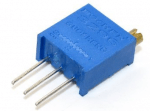In the digital chip design, microcontroller applications and operational amplifiers, the open collector outputs are commonly used either for driving high loads such as relays or for interfacing with other circuits. As we know that BJT is a transistor and it has three terminals (Emitter, Base and Collector) where these terminals can be configured mainly in three switching modes. Those are Common Base, Common Collector and Common Emitter modes. Today, we are going to discuss about open collector … [Read more...]
What is Power Capacitor : Working & Its Applications
A Capacitor is an electrical component, which is used to store electric charges temporarily. The unit of a capacitor is the farad (F). A Power Capacitor is a special type of capacitor, which can operate at higher voltages and has high capacitances. This article gives you a brief introduction to a power capacitor and its working principle, formula, connection, types of applications, and more. Want to learn more about capacitor and how it works? Read our article: Capacitor Working & Its … [Read more...]
What is Ultrasonic Sensor : Working & Its Applications
Ultrasonic sensors are in available for the past many decades and these devices continue to hold huge space in the sensing market because of their specifications, affordability, and flexibility. As the automation industry has been progressing, the employment of ultrasonic sensors in multiple domains such as drones, EV vehicles is emerging. In the year 1914, Fessenden developed the first modern transducer employed in sonar where it can be able to find the items in water but not the direction of … [Read more...]
What is a Trimmer Resistor : Working & Its Applications
Trimmer resistors are also called trim pots or variable resistors that allow you to manually fine-tune the resistance in a circuit. They're often used for calibration in applications like amplifiers and radios to make sure that the circuit output is as close to the ideal level as possible. In this article, we'll discuss everything you need to know about awesome little components like a trimmer resistor and how they work, how they're manufactured, and how you can use them in your own … [Read more...]
What is a 7-segment Display : Working & Its Applications
7 segment display is an old school Opto-Electronic Display device mainly used to display alphabets and digits. As the name suggests, these displays include seven segments that switch ON & OFF to display the required digit or alphabet. The segments in this display are normally single LEDs or liquid crystals. These displays are extensively used in electronic meters, digital clocks, displays in home appliances, basic calculators, cars & different electronic devices that display numerical … [Read more...]
What is Schottky Diode : Working & Its Applications
The Schottky diode, also known as a hot-carrier diode or leaky-carrier diode, is the most popular semiconductor diode invented by Walter H. Schottky in 1926. In the early days, wireless devices & metal rectifiers used cat’s whisker detectors within power applications and these detectors can be considered as primitive Schottky diodes. So, let us see why a Schottky diode is so special? What is Schottky Diode? A Schottky diode is a special type of metal-semiconductor junction diode that c … [Read more...]
What is OR Gate : Circuit, Truth Table & Applications
We all know that logic gates are the devices that stand as functional blocks for many of the digital circuits. Nearly 90%of the electronic devices are designed with logic gates to perform logical operations in those devices. These logic gates are dependent on Boolean algebra where those will generate output depending on the combination of digital signals from the input bits. Based on the kind of logic and the inputs combinations, the result will vary. The one type of logic gate which we are … [Read more...]
What is AND Gate : Truth Table, Working & Its Applications
In the domain of digital electronics logic gates are the devices that perform Boolean operations having two inputs and one output. Depending on the logical gate, the logical functionality changes and the output also gets varied. In the year 1886, in a letter, Charles Pierce stated that how logical functionalities could be performed by switching circuits. Finally, vacuum tubes got replaced by logical operations. And the one logical gate which we are going to discuss today is AND gate. The first … [Read more...]
What is Open Drain : Configuration & Its Applications
In order to have interference with the outside world using microcontrollers, it can be done through pins. These pins act as physical points for an integrated circuit where a PCB connection can be established. Each pin has its own circuitry, and it is configured to pins to allow interference with various kinds of circuits. And the most important point is to select the appropriate pin configuration in the design of an embedded system. Today, this article explains open-drain output configuration, … [Read more...]
What is a Demultiplexer : Working & Its Applications
A Demultiplexer is also called Demux or data distributor and its operation is quite opposite to a multiplexer because it is an inverse to the multiplexer. The multiplexer is a many-to-one circuit whereas the Demultiplexer is a one-to-many circuit. By using Demultiplexer, the transmission of data can be done through one single input to a number of output data lines. Generally, Demultiplexers are used in decoder circuits and Boolean function generators. There are different I/O configurations … [Read more...]
- « Previous Page
- 1
- …
- 7
- 8
- 9
- 10
- 11
- …
- 25
- Next Page »









